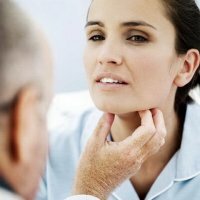Diseases of the adrenal gland and their symptoms
Adrenal glands are small paired glands located above the upper poles of the kidneys. These endocrine organs have a complex structure and perform some functions in the body. In the anatomical structure of the adrenal glands, two parts are distinguished: cerebral and cortical. The inner( brain) part produces stress hormones( catecholamines).The cortex separates several groups of steroids: sex, mineralocorticoids, glucocorticoids.
Content
- 1 adrenal function in men:
- 2 adrenal disease
- 2.1 tumors without hormonal activity
- 2.2 tumors with hormonal activity
- 2.3 Pheochromocytoma: symptoms, diagnosis
- 2.4 Hyperaldosteronism
- 2.5 Cushing
- 2.6 Tumors with the secretion of sex steroids
- 2.7 Primary adrenal insufficiency
Adrenal function in men:
- maintains systemic arterial pressure;
- retain the water-electrolyte balance;
- are involved in the formation of sexual organs( before puberty);
- helps in the adaptation of the body to various stresses;
- activates the central nervous system;
- increase working capacity and muscular strength;
- increase blood sugar level, etc.
Also read "Adrenal Hormones and Their Functions".
Adrenal Diseases
Adrenal gland diseases may manifest as an increase or decrease in their hormonal activity. But part of the disease of this zone does not permanently disrupt the function of endocrine cells.
Several pathologies are distinguished:
- benign neoplasms without hormonal activity;
- malignant neoplasms without hormonal activity;
- neoplasms with hormonal activity;
- hypertrophy of the adrenal cortex with hormonal activity;
- congenital dysfunction of the adrenal cortex;
- decreased adrenal function.
Tumors without hormonal activity
Tumors that do not synthesize biologically active substances can be detected in the cortex and adrenal medulla. Such tumors are called incidentalomas. They can be inherently benign and malignant.
The most informative method of visualization of adrenal tumors is computed tomography( with contrasting).During this study, focal formations can be found, and information on the structure of the tumor and its blood supply can be obtained.
It is also possible to visualize the adrenal tumor by ultrasound. But this type of diagnosis is considered less accurate.
Benign incidents of almost no clinical manifestations. If the cancer is cancerous, there may be symptoms of cancer( intoxication, weight loss, compression of surrounding tissues, disruption of organs and systems).
Tumors with hormonal activity
The results of hormonal tests can reveal the functional activity of the tumor.
There are:
- pheochromocytomas;
- aldosterome;
- corticosteroids;
- androsteromas;
- corticoestroma;
- tumors with mixed hormonal secretion.
Pheochromocytomas are neoplasms from the cells of the adrenal medulla. They are often bilateral( 10-15%).Pheochromocytomas in many cases( up to 10%) are detected outside the adrenal gland( in the abdominal and thoracic cavity, etc.). In every tenth patient, the tumor is malignant. The pheochromocytoma synthesizes and releases catecholamines into the blood.
Aldosteroma is a tumor from the most superficially located cells of the adrenal cortex( glomerular layer).This new formation secretes mineralocorticoids( primarily aldosterone).Excess of these biologically active compounds leads to the development of Connes syndrome( primary hyperaldosteronism).
Corticosteroma is a tumor from the adrenal cortex of the adrenal cortex. Neoplasm from cells in this region can synthesize an excess of glucocorticoids. As a result, the patient with corticosteroid manifests the Itenko-Cushing syndrome( primary hypercorticism).
Androsteromas and corticoestromes are neoplasms of the lowest layer of the adrenal cortex. The cells of this reticular zone have a morphological affinity for the sexual glands. Normally, weak androgens are synthesized in this part of the cortex. Tumors of the mesh layer can excrete into the blood of female and male sex steroids. In women, such neoplasms often lead to virilization. In men, corticoestromes provoke the appearance of female features in appearance.
Pheochromocytoma: symptoms, diagnosis
The main sign of adrenal medullar tumor is arterial hypertension. In patients, in most cases, there are crises in blood pressure. Attacks can be triggered by physical exertion, a change in body position, eating, or emotional experience.
A typical crisis with pheochromocytoma is accompanied by a feeling of fear, trembling, rapid pulse, pale skin. After the pressure comes back to normal, the patient is recorded profuse urination.
The first step in the diagnosis of pheochromocytomas is visualization of the adrenal glands( ultrasound, tomography).Then, blood and urine samples are prescribed. The most informative is the diagnosis of decay products of catecholamines. The adrenaline and norepinephrine themselves are very unstable compounds. They quickly break down after getting into the blood. But their metabolites( metanephrine and normetanephrine) have a much longer period of existence. It is the tests for these substances that are prescribed to patients with suspected pheochromocytoma.
Hyperaldosteronism
Primary hyperaldosteronism( Conn's disease) is manifested by persistent arterial hypertension and neuromuscular disorders. The pressure at the aldosterome is stably high. Hypertension can not be removed with standard therapy regimens. Patients develop early lesions of target organs( heart, eye fundus).A frequent consequence of the disease is stroke of the brain or myocardial infarction.
Conn's disease also manifests itself in muscle weakness, fatigue, seizures, pain in the limbs. Also observed and digestive disorders: worse appetite, constipation occurs.
Over time, aldosterome leads to severe renal damage, which results in kidney failure.
Primary hyperaldosteronism is detected by laboratory diagnosis: the patient is taking blood for aldosterone, renin, potassium. Also special tests are carried out( with sodium, hypothiazide, spironolactone).
Hypercortisy
The Itenko-Cushing syndrome manifests itself:
- is obese;
- redistribution of adipose tissue;
- occurrence of striae;
- hypertension;
- increased blood sugar;
- decreased libido;
- psychological changes( depression).
Men with Isenko-Cushing syndrome change appearance. Legs and arms are very thin( both the fat layer and the muscle volume decrease).Excess subcutaneous tissue is deposited in the abdomen, on the upper half of the trunk, on the face. The skin undergoes dystrophic changes. On the anterior abdominal wall there are wide maroon stretch marks( striae).
Patients are often worried about headache, dizziness, tinnitus. When measuring the pressure, hypertension is fixed. Patients complain of dry mouth, thirst, frequent urination. Usually these symptoms are associated with secondary steroid diabetes. Another characteristic complaint in hypercortisy is a decrease in libido. Men notice the deterioration of potency and the disappearance of sexual desire.
For the diagnosis of Isenko-Cushing syndrome:
- blood test for cortisol;
- daily rhythm of cortisol( morning and evening analysis);
- blood test for adrenocorticotropin;
- small sample with dexamethasone;
- is a large sample with dexamethasone.
It is also necessary to investigate the level of blood electrolytes, glycated hemoglobin and other indicators.
Hypercortisism is often secondary, that is, associated with a brain tumor. To exclude this reason for increasing cortisol levels, a pituitary tomography scan is performed.
Tumors with secretion of sex steroids
Corticoestromes and androsteromas are relatively rare. If such a tumor is detected, then the risk of oncology is high.
In boys before puberty, such neoplasms cause early puberty. If the tumor secretes estrogens, then the child has female sexual characteristics. If the tumor synthesizes androgens, then puberty corresponds to the male.
In adult corticostromal men causes:
- gynecomastia;
- redistribution of adipose tissue to the thighs and buttocks;
- stopping the growth of the beard and mustache;
- increase voice timbre;
- loss of potency.
Androsteroma in adult men is manifested by increased hair growth on the face and body, increased muscle strength and stamina, a decrease in the percentage of fat tissue. Such a tumor can remain undiagnosed for a long time.
To identify corticoestroma and androsterem use:
- blood tests for androgens and estrogens;
- assays for gonadotropins( luteinizing, follicle-stimulating);
- samples with dexamethasone and adrenocorticotropin.
Primary adrenal insufficiency
If both adrenal glands are destroyed, then primary adrenal insufficiency develops. This condition threatens the patient's life.
Symptoms of the disease:
- severe fatigue;
- low blood pressure;
- weight loss;
- darkening of the skin;
- various digestive disorders.
Primary adrenal insufficiency develops as a result of autoimmune or infectious( tuberculosis) inflammation in the glands. The disease can be hidden for a long time. But a variety of stresses increase the symptoms of this pathology. For example, adrenal insufficiency may be due to emotional experiences, ARI, or minor surgical intervention.
Diagnosis of the disease using blood tests for:
- cortisol;
- aldosterone;
- potassium;
- sodium;
- pH.
Endocrinologists perform special tests( with adrenocorticotropin, metiapone).
Doctor-endocrinologist Tsvetkova IG
Recommended for viewing:



